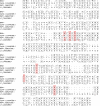Genetic and biochemical characterization of BIM-1, a novel acquired subgroup B1 MBL found in a Pseudomonas sp. strain from the Brazilian Amazon region
- PMID: 37038995
- PMCID: PMC10232235
- DOI: 10.1093/jac/dkad077
Genetic and biochemical characterization of BIM-1, a novel acquired subgroup B1 MBL found in a Pseudomonas sp. strain from the Brazilian Amazon region
Abstract
Objectives: To characterize a novel acquired MBL, BIM-1, in a Pseudomonas #2 (subgroup P. guariconensis) strain isolated from the Aurá river located in the Brazilian Amazon hydrographic basin.
Methods: WGS using an Illumina® MiSeq System was used to characterize the genome of Pseudomonas sp. IEC33019 strain. Southern blotting/hybridization assays were performed to confirm the location of the MBL-encoding gene, blaBIM-1 (Belém Imipenemase). Antimicrobial susceptibility testing, cloning, and biochemical and phenotypic characterization were performed to determine BIM-1 kinetics.
Results: The IEC33019 strain showed high resistance rates to β-lactams, ciprofloxacin and aminoglycosides, being susceptible only to polymyxins and susceptible, increased exposure to aztreonam. WGS analysis revealed a novel acquired MBL-encoding gene, blaBIM-1, found as a gene cassette inserted into a class 1 integron (In1326) that also carried qnrVC1 and aadA11e. In1326 was located in a complex transposon, Tn7122, carried by a 52.7 kb conjugative plasmid (pIEC33019) with a toxin/antitoxin system (vapB/vapC). BIM-1 belongs to the molecular subgroup B1 and shares 70.2% and 64.9% similarity with SIM-1 and IMP-1, respectively. Kinetics analysis of BIM-1 showed hydrolytic activity against all β-lactams tested.
Conclusions: BIM-1 is a novel acquired MBL encoded by a gene carried by mobile genetic elements, which can be transferred to other Gram-negative bacilli (GNB). Because the IEC33019 strain was recovered from a river impacted by a populous metropolitan region with poor basic sanitation and served by limited potable freshwater, it would be important to establish the role of the BIM-1-producing GNB as nosocomial pathogens and/or as colonizers of the riverside population in this geographical region.
© The Author(s) 2023. Published by Oxford University Press on behalf of British Society for Antimicrobial Chemotherapy.
Figures



Similar articles
-
Genetic and biochemical characterization of HMB-1, a novel subclass B1 metallo-β-lactamase found in a Pseudomonas aeruginosa clinical isolate.J Antimicrob Chemother. 2017 Apr 1;72(4):1068-1073. doi: 10.1093/jac/dkw554. J Antimicrob Chemother. 2017. PMID: 28065891
-
Description of IMP-31, a novel metallo-β-lactamase found in an ST235 Pseudomonas aeruginosa strain in Western Germany.J Antimicrob Chemother. 2015 Jul;70(7):1973-80. doi: 10.1093/jac/dkv079. Epub 2015 Apr 2. J Antimicrob Chemother. 2015. PMID: 25835992
-
Characterization of the novel plasmid-encoded MBL gene blaAFM-1, integrated into a blaIMP-45-bearing transposon Tn6485e in a carbapenem-resistant Pseudomonas aeruginosa clinical isolate.J Antimicrob Chemother. 2021 Dec 24;77(1):83-88. doi: 10.1093/jac/dkab342. J Antimicrob Chemother. 2021. PMID: 34545931
-
Predominance of carbapenem-resistant Pseudomonas aeruginosa isolates carrying blaIMP and blaVIM metallo-β-lactamases in a major hospital in Costa Rica.J Med Microbiol. 2015 Jan;64(Pt 1):37-43. doi: 10.1099/jmm.0.081802-0. Epub 2014 Oct 29. J Med Microbiol. 2015. PMID: 25355933
-
Molecular epidemiology of clinical Pseudomonas aeruginosa isolates carrying IMP-1 metallo-beta-lactamase gene in a University Hospital in Turkey.Microb Drug Resist. 2007 Fall;13(3):191-8. doi: 10.1089/mdr.2007.748. Microb Drug Resist. 2007. PMID: 17949306
Cited by
-
Strategies to Name Metallo-β-Lactamases and Number Their Amino Acid Residues.Antibiotics (Basel). 2023 Dec 16;12(12):1746. doi: 10.3390/antibiotics12121746. Antibiotics (Basel). 2023. PMID: 38136780 Free PMC article. Review.
-
Pseudomonas guariconensis Necrotizing Fasciitis, United Kingdom.Emerg Infect Dis. 2024 Jan;30(1):185-187. doi: 10.3201/eid3001.231192. Emerg Infect Dis. 2024. PMID: 38147508 Free PMC article.
-
Molecular Epidemiology of Pseudomonas aeruginosa in Brazil: A Systematic Review and Meta-Analysis.Antibiotics (Basel). 2024 Oct 17;13(10):983. doi: 10.3390/antibiotics13100983. Antibiotics (Basel). 2024. PMID: 39452249 Free PMC article. Review.
-
Genomic Characterization of IMP-Producing Pseudomonas aeruginosa in Bulgaria Reveals the Emergence of IMP-100, a Novel Plasmid-Mediated Variant Coexisting with a Chromosomal VIM-4.Microorganisms. 2023 Sep 9;11(9):2270. doi: 10.3390/microorganisms11092270. Microorganisms. 2023. PMID: 37764114 Free PMC article.
References
Publication types
MeSH terms
Substances
LinkOut - more resources
Full Text Sources
Miscellaneous

